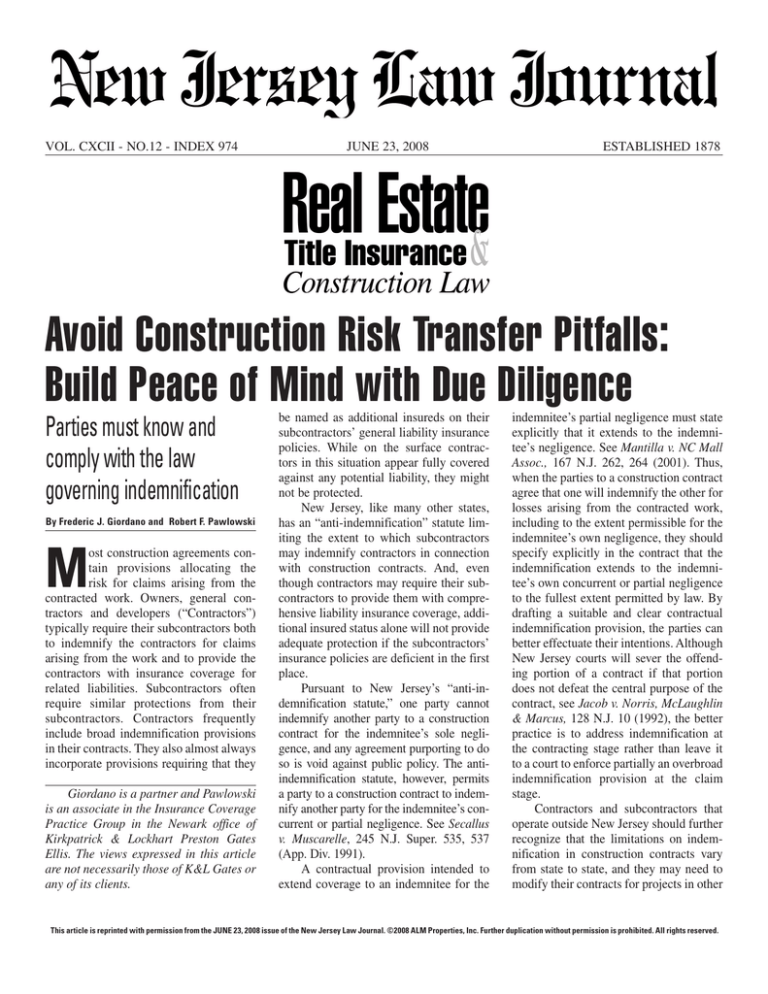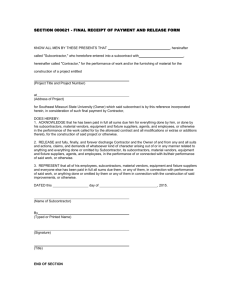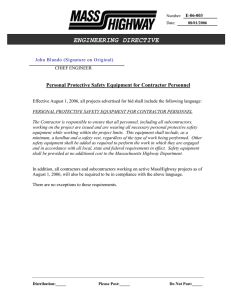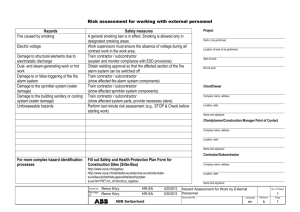
VOL. CXCII - NO.12 - INDEX 974
JUNE 23, 2008
ESTABLISHED 1878
Avoid Construction Risk Transfer Pitfalls:
Build Peace of Mind with Due Diligence
Parties must know and
comply with the law
governing indemnification
By Frederic J. Giordano and Robert F. Pawlowski
M
ost construction agreements contain provisions allocating the
risk for claims arising from the
contracted work. Owners, general contractors and developers (“Contractors”)
typically require their subcontractors both
to indemnify the contractors for claims
arising from the work and to provide the
contractors with insurance coverage for
related liabilities. Subcontractors often
require similar protections from their
subcontractors. Contractors frequently
include broad indemnification provisions
in their contracts. They also almost always
incorporate provisions requiring that they
Giordano is a partner and Pawlowski
is an associate in the Insurance Coverage
Practice Group in the Newark office of
Kirkpatrick & Lockhart Preston Gates
Ellis. The views expressed in this article
are not necessarily those of K&L Gates or
any of its clients.
be named as additional insureds on their
subcontractors’ general liability insurance
policies. While on the surface contractors in this situation appear fully covered
against any potential liability, they might
not be protected.
New Jersey, like many other states,
has an “anti-indemnification” statute limiting the extent to which subcontractors
may indemnify contractors in connection
with construction contracts. And, even
though contractors may require their subcontractors to provide them with comprehensive liability insurance coverage, additional insured status alone will not provide
adequate protection if the subcontractors’
insurance policies are deficient in the first
place.
Pursuant to New Jersey’s “anti-indemnification statute,” one party cannot
indemnify another party to a construction
contract for the indemnitee’s sole negligence, and any agreement purporting to do
so is void against public policy. The antiindemnification statute, however, permits
a party to a construction contract to indemnify another party for the indemnitee’s concurrent or partial negligence. See Secallus
v. Muscarelle, 245 N.J. Super. 535, 537
(App. Div. 1991).
A contractual provision intended to
extend coverage to an indemnitee for the
indemnitee’s partial negligence must state
explicitly that it extends to the indemnitee’s negligence. See Mantilla v. NC Mall
Assoc., 167 N.J. 262, 264 (2001). Thus,
when the parties to a construction contract
agree that one will indemnify the other for
losses arising from the contracted work,
including to the extent permissible for the
indemnitee’s own negligence, they should
specify explicitly in the contract that the
indemnification extends to the indemnitee’s own concurrent or partial negligence
to the fullest extent permitted by law. By
drafting a suitable and clear contractual
indemnification provision, the parties can
better effectuate their intentions. Although
New Jersey courts will sever the offending portion of a contract if that portion
does not defeat the central purpose of the
contract, see Jacob v. Norris, McLaughlin
& Marcus, 128 N.J. 10 (1992), the better
practice is to address indemnification at
the contracting stage rather than leave it
to a court to enforce partially an overbroad
indemnification provision at the claim
stage.
Contractors and subcontractors that
operate outside New Jersey should further
recognize that the limitations on indemnification in construction contracts vary
from state to state, and they may need to
modify their contracts for projects in other
This article is reprinted with permission from the JUNE 23, 2008 issue of the New Jersey Law Journal. ©2008 ALM Properties, Inc. Further duplication without permission is prohibited. All rights reserved.
2
NEW JERSEY LAW JOURNAL, JUNE 23, 2008
states.
Indemnification is only one part of risk
transfer. Insurance is the other part. The
anti-indemnification statute’s prohibition
against indemnifying an indemnitee for its
“sole negligence” does not impact insurance policies to which the indemnitee is
added as an additional insured. The statute
specifically carves out an exception, stating
that it “shall not affect the validity of any
insurance contract, workmen’s compensation or agreement issued by an authorized
insurer.” See N.J.S.A. §2A:40A-1; see
N.J.S.A. §2A:40A-2 (containing no “insurance exception” for design professionals).
Thus, while an indemnitor may not
indemnify the other party to a construction contract for the indemnitee’s sole
negligence, the indemnitor can purchase
insurance that extends additional insured
coverage to the indemnitee for its sole negligence. Whether to provide such coverage
is a business decision that the parties can
make — and factor into the contract — at
the time of contracting. To the extent that
one party agrees to provide broad additional insured coverage to the other, both
should ensure the contract specifies that
the former’s policy will add the latter as
an additional insured on an endorsement
that includes coverage for the additional
insured’s sole negligence, such as the insurance industry standard endorsement CG
20 10 11 85 (drafted and made available
for use by the Insurance Services Office,
an insurance industry-funded organization
that drafts standard form insurance policy
language), or otherwise specifies that additional insured coverage will extend to the
additional insured’s sole negligence. To
further effectuate the parties’ intentions,
the contract should indicate that such additional insured coverage will be primary and
noncontributory to the additional insured’s
own insurance.
When a subcontractor agrees to provide a contractor with additional insured
coverage – whether or not such coverage
extends to the contractor’s sole negligence
– both parties should confirm that the subcontractor not only names the contractor
as an additional insured on the subcontractor’s liability insurance policies, but also
that the policies provide all the coverage
that the subcontractor promised in the construction agreement. If the subcontractor
does not provide the agreed coverage, the
contractor may not receive the intended
protection from third party claims, exposing the subcontractor to a breach of contract claim for failure to procure insurance
and the contractor to potentially uninsured
liabilities.
A contractor should consider specifying the type of insurance coverage it wants
perhaps right down to specific policy
forms – in its contract with its subcontractor. By way of example, it is generally better for a contractor to be named
individually as an additional insured on a
specific endorsement, instead of named as
an additional insured pursuant to a blanket
endorsement. Many blanket endorsements
provide coverage only as required by contract and unnecessarily inject contractual
issues into the insurance equation or add
policy exclusions that could eliminate the
intended coverage.
Next, a contractor should confirm
that its subcontractor has fulfilled the
contract’s insurance requirement. A subcontractor typically provides a contractor with a “Certificate of Insurance” as
evidence that the subcontractor has added
the contractor as an additional insured
on the subcontractor’s liability insurance
policy. But, insurance companies have
taken the position that a Certificate of
Insurance — usually issued by a broker
itself — provides no coverage for a contractor if the policy contains no additional
insured endorsement. This position has
found support in some courts. Likewise, a
Certificate of Insurance does not describe
the full extent of the subcontractor’s insurance coverage. So, without more than
a Certificate of Insurance, a contractor
cannot be certain that it qualifies as an
192 N.J.L.J. 974
additional insured under its subcontractor’s policy, or that such policy provides
the coverage specified in the construction
agreement.
The best practice for a contractor is
to review any policy to which it has been
added as an additional insured, including
all endorsements thereto, to confirm its
status and the coverage terms. To facilitate
such a review, a contractor should require
in the construction contract that the subcontractor provide the contractor with
a copy of any liability insurance policy
by a certain date, or upon the contractor’s demand. Recognizing that it may
be impractical for a large contractor to
review every insurance policy from every
subcontractor it retains, however, a contractor should consider reviewing at least
the policies for those trades most likely to
give rise to claims like roofing and framing and for high value projects. Also, a
subcontractor, or its insurance broker,
should compare any policy against the
construction contract to ensure that the
subcontractor complies with its contractual obligations. To the extent that the
construction contract spans more than
one policy term, both parties further
should ensure continued compliance at
subsequent insurance renewals.
Construction projects always have
the potential to go wrong, and the parties to construction contracts usually
agree at the outset how they will allocate
any resulting liabilities. Insurance and
indemnification together can provide
this risk transfer. To effectuate their
intentions properly, however, the parties must know and comply with the
law governing indemnification. They
also must identify and obtain appropriate insurance protection. Contractors
and subcontractors who are aware of
the potential pitfalls associated with
indemnification agreements and promises to insure can take care to protect their
interests to the fullest extent possible,
thereby building peace of mind. ■





